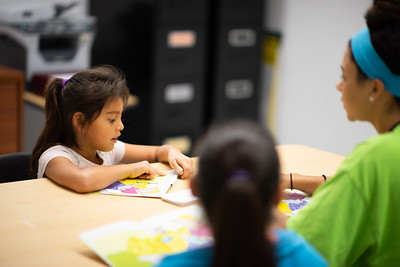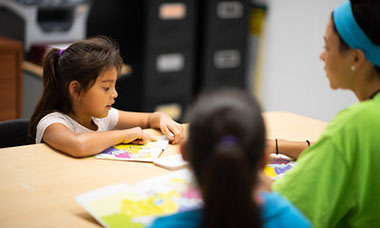What is Guided Reading?

TAMU-CC Student, Maddie Woods works with a small group of second graders on literacy instruction.
In recent years, “guided reading” has been attacked in some circles. My feeling is that this may be due to misconceptions about the instructional strategy. A teacher with whom I worked years ago stopped me in our school’s hallway one day and said, “Why are we having more workshops on the topic of guided reading? I’ve been doing guided reading for years!” This teacher actually taught guided reading groups right outside of my office door every day and what I heard was definitely not guided reading! So, let’s take a look at the tenets of guided reading instruction.
Fountas and Pinnell (2012) define guided reading as “an instructional context within which the precise teaching moves and language choices are related to the behaviors observed, moment by moment, and which guide the reader to engage in problem solving that expands his or her reading power” (p. 279),and Ford and Opitz (2008) assert that the purpose of guided reading is to build independence in the reader by inviting children to read a book that is matched to their current level of progress. Let’s break down these definitions.
- “precise teaching moves” – prompting and teaching is directly related to the reading behaviors the children are exhibiting
- “language choices” – the teacher uses explicit prompts and questions that will result in a shift in the child’s reading behaviors; if not, the teacher makes note of this and tries on different language at the next opportunity
- “behaviors observed” – all this teaching depends on a very skilled teacher who is able to notice and name what the child is (and is not) attending to
- “moment by moment” – each second of instruction counts; no time is lost and the teacher pays full attention to each move the child makes
- “guide the reader” – as in “guided reading”; it is acceptable for the teacher to prompt and teach during the reading of a new text at the child’s instructional level in order to lift the child’s reading
- “engage in problem solving” – the child, however, is called upon to do as much of the “heavy lifting” as she can under the teacher’s guidance; there should be several opportunities in a little book to work things out
- “expands his or her reading power” – all of this “working out” will help the child to gradually take on board more strategies for reading continuous text
- “matched to current level of progress” – books used during guided reading instruction should be those that are within the child’s control for the most part, with a few places to problem-solve; while there is a recommended accuracy percentage (90-95%), there is some “wiggle room” here, depending on the child and the text
- “carefully scaffolded by the teacher” – the teacher’s use of language depending on the behaviors observed
Based on the explanation of these definitions, I’m not sure there is room for confusion!
Finding Balance Within a Literacy Framework
The term “balanced literacy” has been tossed about so much that it seems to have lost its meaning. It’s also most likely lost its novelty, as many terms do in the field of education. If we keep our focus on what is best for readers in our classrooms, we can help keep the balanced literacy framework sacred and use it as it was intended – to give each child what they need and not what we think they need based on our own feelings and opinions. The National Council of Teachers of English released a position statement (2019) clearly stating that multiple instructional formats (i.e., shared reading, guided reading, literature discussion circles, and individualized instruction)should be utilized daily in classrooms. Rasinski and Padak(2004) advocated for a more “complex view of balance,” (p. 92) where teachers need to reconsider the how they weigh the components of balanced literacy, again, according to student needs. Applegate, Applegate, and Turner (2010) contend by discussing that the role of literacy leaders is to help teachers “achieve a healthy balance” where all students are provided with the instruction they need to grow into successful readers (p. 213).
Included in this “balance” is phonics instruction. Calkins (2019) and Morris (2015), among others, agree that phonics is better taught (and can be accomplished quite successfully in the classroom of a trained teacher) in tandem with reading and writing instruction. Writing instruction, in fact, is a perfect venue to teach children to hear and record sounds in speech, and this learning transfers over to reading words. It’s also important that teachers are careful to not over-emphasize phonics instruction with students who do not need it – again, this “extra emphasis on repetition and phonics may mean that typically developing students don’t get the other instruction they need in vocabulary, comprehension, writing, and higher-order thinking” (Calkins, p. 7).
A study of 30 first grade teachers (Pressly et al., 2001) using classroom observations and interviews found that the most effective teachers implemented a “balancing of skills instruction and whole language,” teaching skills in the context of continuous reading and writing (p. 46). For a discussion on how another school successfully implemented a balanced literacy framework (including guided reading), see Fisher and Frey(2007).
The Cueing Systems
“Reading is more than looking at individual words and saying them” (Fountas, 2012, p. 273). This statement embodies the work I have done in my years as a classroom teacher, reading specialist, literacy coach and consultant, and university instructor. Let me be clear – reading the words is important, obviously; however, it should not be the focus of reading instruction. And in many classrooms I have visited, it unfortunately is. Doyle (2018) says this: Readers “do not apply a narrow, letter-by-letter sounding out process to identify words; rather, proficient readers analyze words in flexible ways to identify a broad range of words” (p. 39).
Phonics is attended to during guided reading lessons; it’s just attended to during the reading of a continuous text and not as an arbitrary “add-on” to the lesson. It’s also systematic and sequential in that the skills addressed are based on the complexities presented at each level of text as the child gradually moves along the continuum and takes on board “flexible and efficient” ways of working with more complex visual information (Fountas & Pinnell, 2012, p. 268) while also using other cueing sources (meaning and syntax). In her recent position statement related to the latest “reading war,” Lucy Calkins (2019) reminds us that “successful reading integrates all three cueing systems” (p. 3).
During guided reading lessons for emergent and early readers, children are not encouraged to “guess” when they come to a point of difficulty. They are encouraged, rather, to use the strategies they are being taught to work toward solutions of what the tricky word might be. This includes using and integrating (cross-checking) all cueing systems, not solely visual information. Pressly et al. (2001) found that the most effective teachers taught students to attend to multiple cues while reading continuous text. When children make an error while reading, these errors are not ignored. While the teacher might decide to let an error go while the child is reading if the error makes sense, this error will be noted, not as a “…deficit, but a window into the child’s problem-solving” (Pinnell & Fountas, 2015, p. 25). The teacher will return to it later, as not to disrupt the child’s reading (Allington, 2019).
Texts for Guided Reading Instruction
Texts used with young readers during guided reading instruction should be at students’ instructional level (i.e., 90 to 95% accuracy rate). Fountas and Pinnell (2012) emphasize that these texts are on “the edge of [students’] learning” (p. 269). Additionally, teachers should consider the content, vocabulary, text structure, sentence structure complexity, among other criteria when selecting books. Above all, “teachers select books with readers in mind” (Pinnell & Fountas (2015, p. 26). In order to do this, teachers must be keen observers of students and use data, such as running records, to work within children’s zones of proximal development. Using a gradient text leveling system (i.e., books are leveled incrementally) allows teachers to gradually increase the difficulty level of texts as students take on new strategies at each level. Morris (2015) advocated for the use of these texts, stating that they should contain the repetition of high frequency words and decodable spelling patterns, while also containing interesting story lines.
After analyzing responses from 1,563 teachers, Ford and Opitz (2008) wrote that teachers reported that they only used instructional level texts about half the time during guided reading instruction. This led the researchers to wonder: since coaching is inherent in the process of guided reading instruction, how could using books that are too easy or too difficult aid this process? “Guided reading was designed as a return to small group reading instruction to address the overuse of whole group instruction during which many students were not reading texts at their instructional level” (Ford & Opitz, p. 318). Teachers are also encouraged to use a variety of text types and genres (Rasinski & Padak, 2004).
The Red Rocket Readers include a plethora of books that meet the above qualifications. Here are several examples.
- Let’s Play Ball (Level B): This book contains repetition (p. 2: We like to throw balls. p. 3: We like to hit balls.) and easy high frequency words. It also includes a different action word on each page where the child has to check the illustration and attend to the visual information in order to detect the change on each page.
- The Junk Box (Level B): This book also contains repetition; however, the repetition is more sophisticated and includes natural language patterns (p. 2: Can you make hats out of this old junk? p. 3: Can you make masks out of this old junk?). The high frequency words are more difficult than in Let’s Play Ball and the children, again, must attend to the illustrations as well as the print to watch for changes on each page.
- In Everyone Reads (Level D), there is some repetition (p. 2: My mother likes to cook. She makes good food. Yum! p. 3: She reads books about cooking. p. 4: My father likes to play sports. He likes to watch games, too. p. 5: He reads books about sports.). There are slight variations in the pattern on each page, though, requiring the reader to look carefully and attend to visual information. At the same time, the language in this book is natural while still supporting the reader. At this level, the reader also has to use phonics knowledge to decode some of the words, as not all information can be gleaned from the illustration.
So, if you’re looking for me, I’ll be in classrooms, both elementary school and university, sharing with teachers the power of guided reading instruction.
Happy Reading!
Bethanie
References
Allington, R. (2019). The hidden push for phonics legislation.Tennessee Literacy Journal, 1(1), 7-20.
Applegate, A. J., Applegate, M. D., & Turner, J. (2010). Learning disabilities or teaching disabilities? Rethinking literacy failure. The Reading Teacher, 64(3). 211-213.
Calkins, L. (2019). No one gets to own the science of reading.https://readingandwritingproject.org/news/no-one-gets-to-own-the-term-the-science-of-reading
Clay, M. M. (1979). Reading: The patterning of complex behavior (2nd Ed.). Aukland, New Zealand: Heinemann.
Doyle, M. A. (2018). Communicating the power of Reading Recovery and Literacy Lessons instruction for Dyslexic learners: An ethical response. Journal of Reading Recovery, Fall, 35-50.
Fawson, P. C., & Reutzel, D. R. (2000). But I only have a basal: Implementing guided reading in the early grades. The Reading Teacher, 54(1), 84-97.
Fisher, D., & Frey, N. (2007). Implementing a schoolwide literacy framework: Improving achievement in an urban elementary school. The Reading Teacher, 61(1), 32-43.
Ford, M., & Opitz, M. F. (2008). A national survey of guided reading practices: What we can learn from primary teachers. Literacy Research and Instruction, 47(4), 309-331.
Fountas, I. C., & Pinnell, G. S. (2012). Guided reading: The romance and the reality. The Reading Teacher, 66(4), 268-284.
International Literacy Association. (2019). Children experiencing reading difficulties: What we know and what we can do.https://www.literacyworldwide.org/docs/default-source/where-we-stand/ila-children-experiencing-reading-difficulties.pdf
Morris, D. (2015). Preventing early reading failure: An argument. The Reading Teacher, 68(7), 502-509.
National Council of Teachers of English. (2019, December). The Act of Reading: Instructional Foundations and Policy Guidelines. www2.ncte.org/statement/the-act-of-reading
Pinnell, G. S, & Fountas, I. C. (2015). Contributions of the works of Marie Clay to guided reading instruction. Journal of Reading Recovery, Spring, 24-27.
Pressly, M., Wharton-McDonald, R., Allington, R., Collins Block, C., Morrow, L., Tracey, D., Baker, K., Brooks, G., Cronin, J., Nelson, E., & Woo, D. (2001). A study of effective first-grade literacy instruction. Scientific Studies of Reading, 5(1), 35-58.
Raskinski, T., & Padak, N. (2004). Beyond consensus-beyond balance: Toward a comprehensive literacy curriculum. Reading & Writing Quarterly, 20(1), 101-102
Share this Post

